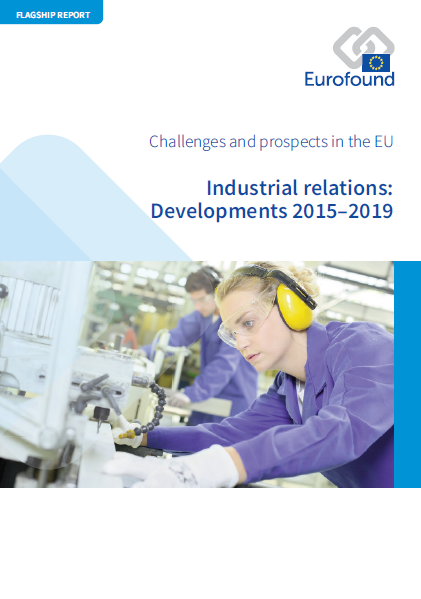
No âmbito do seu mandato para promover o diálogo entre parceiros sociais, a Eurofound acompanha e analisa a evolução dos sistemas de relações laborais a nível da UE e nos Estados-Membros da UE há mais de 40 anos. Este relatório emblemático baseia-se no trabalho realizado neste contexto durante o último período de programação (2015-2019). Baseia-se na monitorização exaustiva dos sistemas de relações laborais e do diálogo social realizada pela Eurofound numa base contínua. O objetivo geral do relatório consiste em ajudar os decisores políticos e os intervenientes nas relações laborais a compreenderem os desafios com que se defronta o diálogo social e a identificarem possíveis formas de contribuir para o desenvolvimento de sistemas de relações laborais equilibrados e eficientes.
Key findings
A nível europeu, houve um volume impressionante de iniciativas conjuntas que emergiram do diálogo social europeu, mas houve poucos acordos.
Em alguns setores, receia-se que as exigências dos parceiros sociais no sentido de implementarem acordos através de legislação europeia tenham sido rejeitadas e que seja necessário garantir uma melhor articulação entre as instâncias nacionais e da UE.
A nível nacional, as relações laborais continuam a ser muito diversas, no seio da UE. A análise da Eurofound sugere uma clara divisão entre os países (nórdicos e continentais) que registam os índices mais elevados de democracia laboral e os Estados-Membros do Sul, liberais e da Europa Central e Oriental.
Menos de um em cada três locais de trabalho (com mais de 10 trabalhadores) na UE (29 %) possui alguma forma de representação dos trabalhadores. Os requisitos legislativos constituem um fator fundamental para garantir tal representação.
Investir no diálogo social em «bons tempos» ajuda a garantir que este possa ser utilizado em tempos de crise. Uma análise das primeiras respostas políticas à pandemia da COVID-19 mostra que o envolvimento dos parceiros sociais foi, em geral, mais robusto nos países onde o diálogo social tem tradicionalmente desempenhado um papel importante.
List of tables
Table 1: Main EU cross-sectoral joint texts, November 2014–November 2019
Table 2: European Pillar of Social Rights
Table 3: Results of the mapping exercise on capacity gaps and needs among national social partners
Table 4: Social partners’ involvement in social and labour policymaking
Table 5: Recitals with explicit references to capacity building in the 2019 CSRs
Table 6: Contextual indicators for industrial democracy
Table 7: Dimensions and indicators of industrial democracy
Table 8: Industrial democracy clusters in the EU27 and the UK, 2008–2012 and 2013–2017
Table 9: Selected developments in social partner organisations, 2014–2019
Table 10: Member States in which respondents were most and least likely to have received training as an employee representative
Table 11: Employee representatives perceiving levels of appreciation from employees by industrial democracy cluster (%)
Table 12: Direct and indirect forms of employee involvement in the most important organisational change
Table 13: Views of management and employee representatives on the degree of influence of employees and their representatives
Table 14: Extent of mutual trust between employee representatives and management (%)
Table A1: Types of employee representatives included in the ECS 2019
List of figures
Figure 1: European social dialogue outcomes by type of text (as at 29 July 2020)
Figure 2: National social partners’ involvement in peak-level social dialogue in 2018
Figure 3: Trade union density rates by industrial democracy cluster, 2000, 2014 and 2018 (%)
Figure 4: Collective bargaining coverage rates by industrial democracy cluster, 2000, 2014 and 2018 (%)
Figure 5: Private sector collective bargaining coverage and patterns by industrial democracy cluster, 2019 (%)
Figure 6: Prevalence and type of workplace-level employee representation by country and industrial democracy cluster (%)
Figure 7: Proportion of employees covered by official employee representation by industrial democracy cluster
Figure 8: Proportion of companies in the ECS to which certain legal rules and size thresholds on employee representation apply
Figure 9: Probability that any form of employee representation will exist in an establishment by establishment size and sector (%)
Figure 10: Influence of legal rules and thresholds on probability of representation (%)
Figure 11: Influence of company employment developments, competitiveness and workforce structure on probability of representation (%)
Figure 12: Years of experience as an employee representative by gender (%)
Figure 13: Proportion of respondents by type of representation and establishment size
Figure 14: Working time available to employee representatives by industrial democracy cluster (%)
Figure 15: Training for employee representatives by type and establishment size (%)
Figure 16: Access of employee representatives to funding for external advice by type of representation and establishment size (%)
Figure 17: Proportion of employee representatives reporting estimated shares of trade union membership in their establishments (%)
Figure 18: Employee representatives meeting with employees during and outside working hours (%)
Figure 19: Existence and use of a dedicated social media account to communicate with employees by length of experience of the employee representative (%)
Figure 20: Employee representatives receiving information (financial, employment and strategic) from management by industrial democracy cluster (%)
Figure 21: Employee representatives expressing satisfaction with the quality of information and reporting receiving it in good time (%)
Figure 22: Employee representatives’ involvement in various types of pay negotiations (%)
Figure 23: Employee representatives’ involvement in pay negotiations by industrial democracy cluster (%)
Figure 24: Employee representatives’ involvement in pay negotiations by type of representation (%)
Figure 25: Employee representatives reporting organisational changes since 2016 (%)
Figure 26: Areas of most important change since 2016, as reported by employee representatives (%)
Figure 27: Involvement of employee representatives in the most important organisational change by industrial democracy cluster (%)
Figure 28: Initiator and form of social dialogue (%)
Figure 29: Forms of indirect and direct employee involvement in the most important organisational change (%)
Figure 30: Distribution of combinations of direct and indirect employee involvement by type of employee representation (%)
Figure 31: Employee representatives’ views on direct involvement of employees (%)
Figure 32: Employee representatives’ views on influence of representatives and employees on major organisational changes (%)
Figure 33: Employee representatives’ views on great or moderate influence of employees and representatives on organisational change by area (%)
Figure 34: Employee representatives’ views on levels of trust in management and whether management listens (%)
Figure 35: Trust in and relationship with management by frequency of meeting (%)
- Number of pages
-
120
- Reference nº
-
EF20023
- ISBN
-
978-92-897-2137-0
- Catalogue nº
-
TJ-06-20-066-EN-N
- DOI
-
10.2806/994718
- Permalink
Cite this publication
Eurofound (2020), Industrial relations: Developments 2015–2019, Challenges and prospects in the EU series, Publications Office of the European Union, Luxembourg

